Table of Contents
Introduction
I recently purchased a couple of USB-C soldering irons, and just thought I’d take some photos and try them out briefly. If you’re interested in USB-C soldering irons, it is also worth checking out A Soldering Iron for Christmas
Motivation
I’m working on a USB-C power source, and I wanted to be able to apply decent loads for testing it in real-life. It seemed that soldering irons could be interesting! I was also finding it hard to lug my heavy soldering station around whenever I wished to be mobile with some soldering tools, so USB-C PD seemed like a great problem-solver for soldering irons.
What Soldering Iron?
I already have a normal JBC soldering station, so it made sense to try out a couple of USB-C soldering irons that appear to work with JBC soldering tips and clones. I can very easily compare the difference between them, and I already have genuine JBC tips and am used to them. If you’re new to them, then there are several ranges of tips; the most general purpose ones are the C245 range. There is also a smaller C210 range. I use both, they are great. However the C210 range is the one I use 90% of the time, for surface-mount and through-hole work. In fact I use a single C210 tip for 90% of the time too! The tip has been in use for close to a decade, and is still working fine (the JBC soldering station reduces the tip temperature when not in use, it makes the tips last for ages). I was hoping that the USB-C soldering iron would have the same feature, because the tips are a bit pricey.
I chose a USB-C soldering iron called Sequre S60 and it uses C210 tips. It currently costs £40 for the pack as shown here:
 (Image source: AliExpress)
(Image source: AliExpress)
What’s Inside the Kit?
The kit came with one curved pointy tip, a little stand, a European charger, USB cable, printed instructions : ) and stickers, all in a zip-around case.
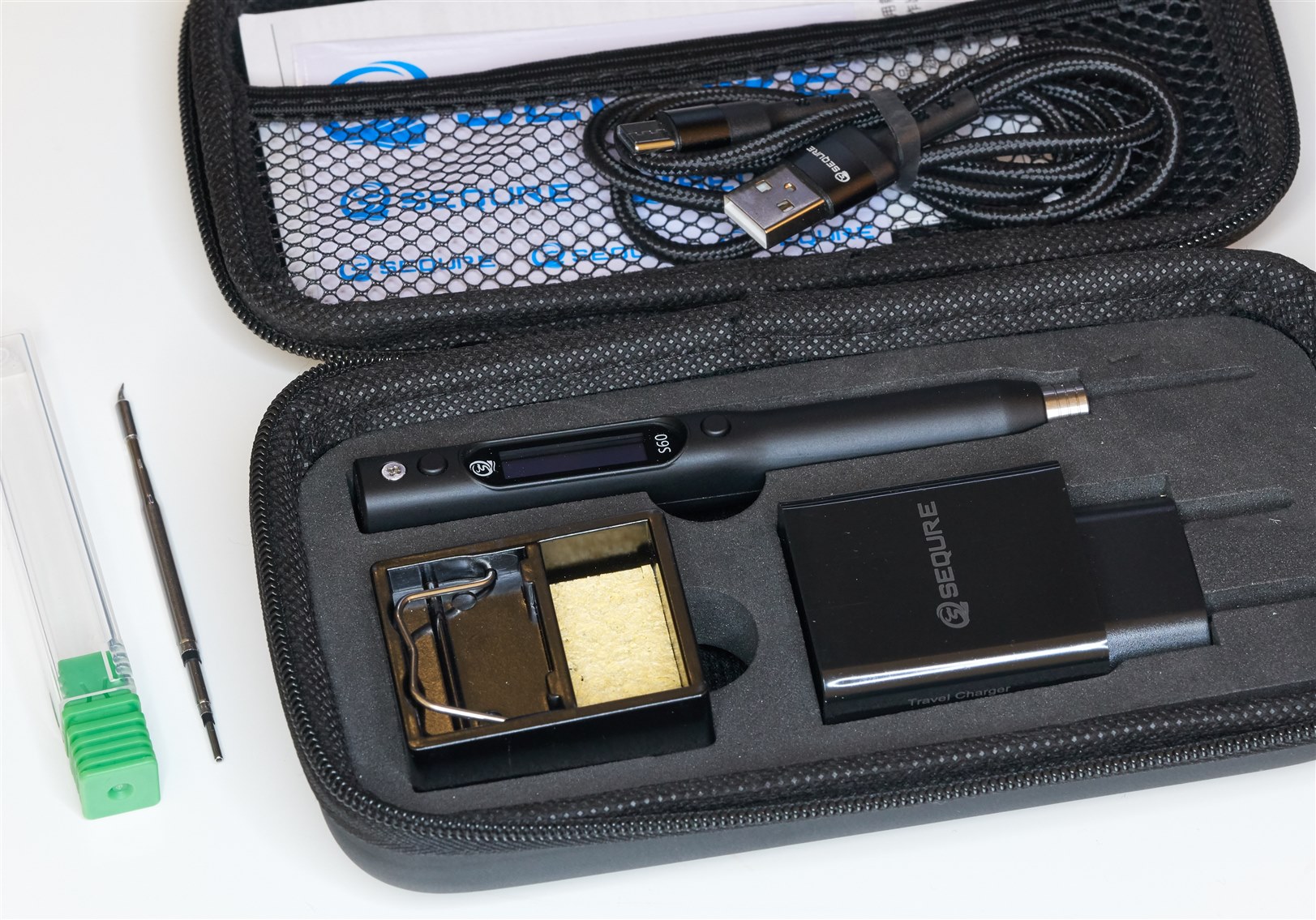
The soldering iron enclosure is made from two halves of very well-fitted plastic, no sharp edges, and it feels good. The normal JBC soldering iron is made of similar-feeling plastic too.
Using It
The iron feels pretty good to hold; the body is cylindrical in the portion where it is held by fingers. It is only slightly thicker than the JBC tool.
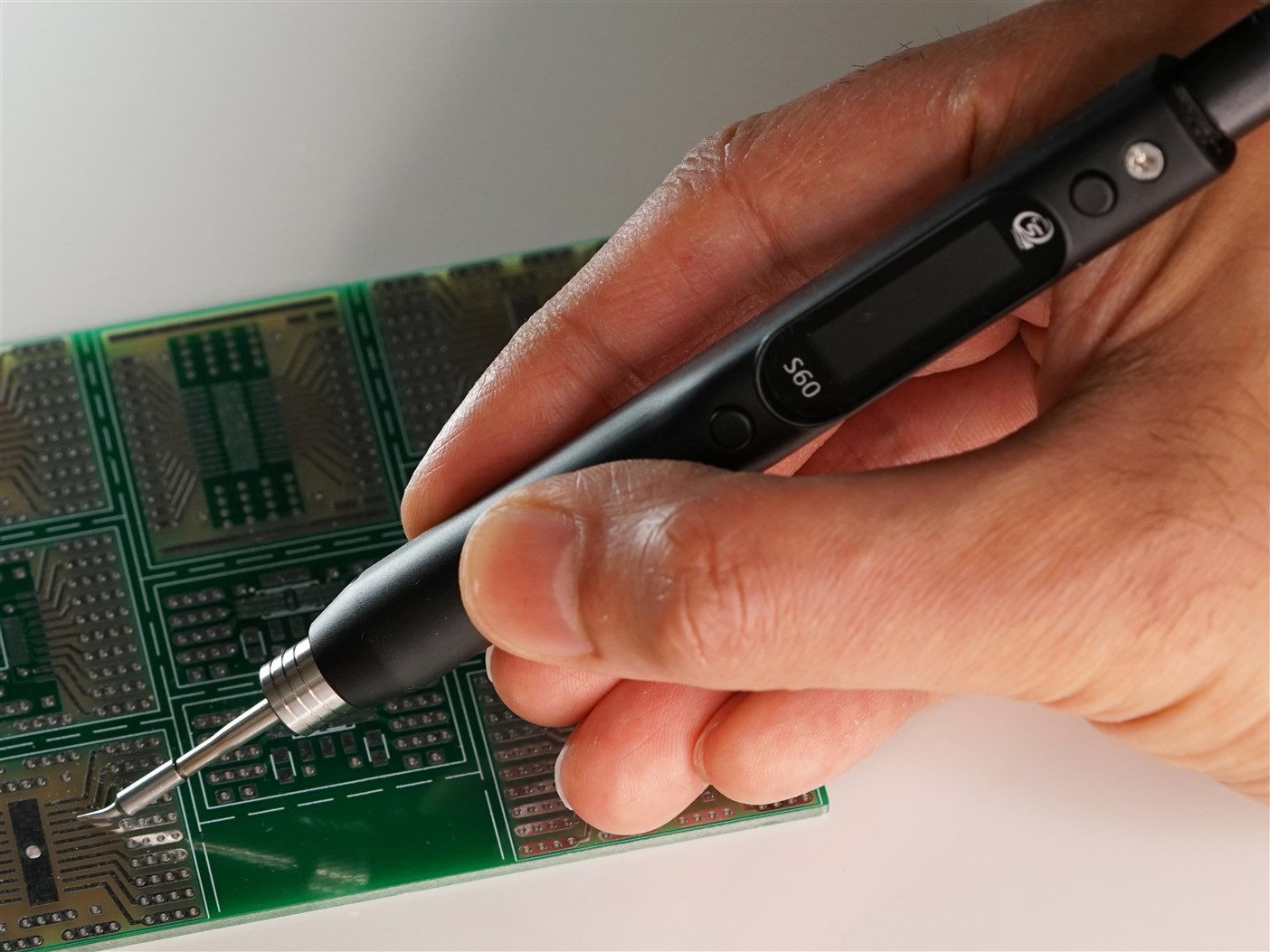
The photo below shows the differences between JBC tool and the Sequre S60:
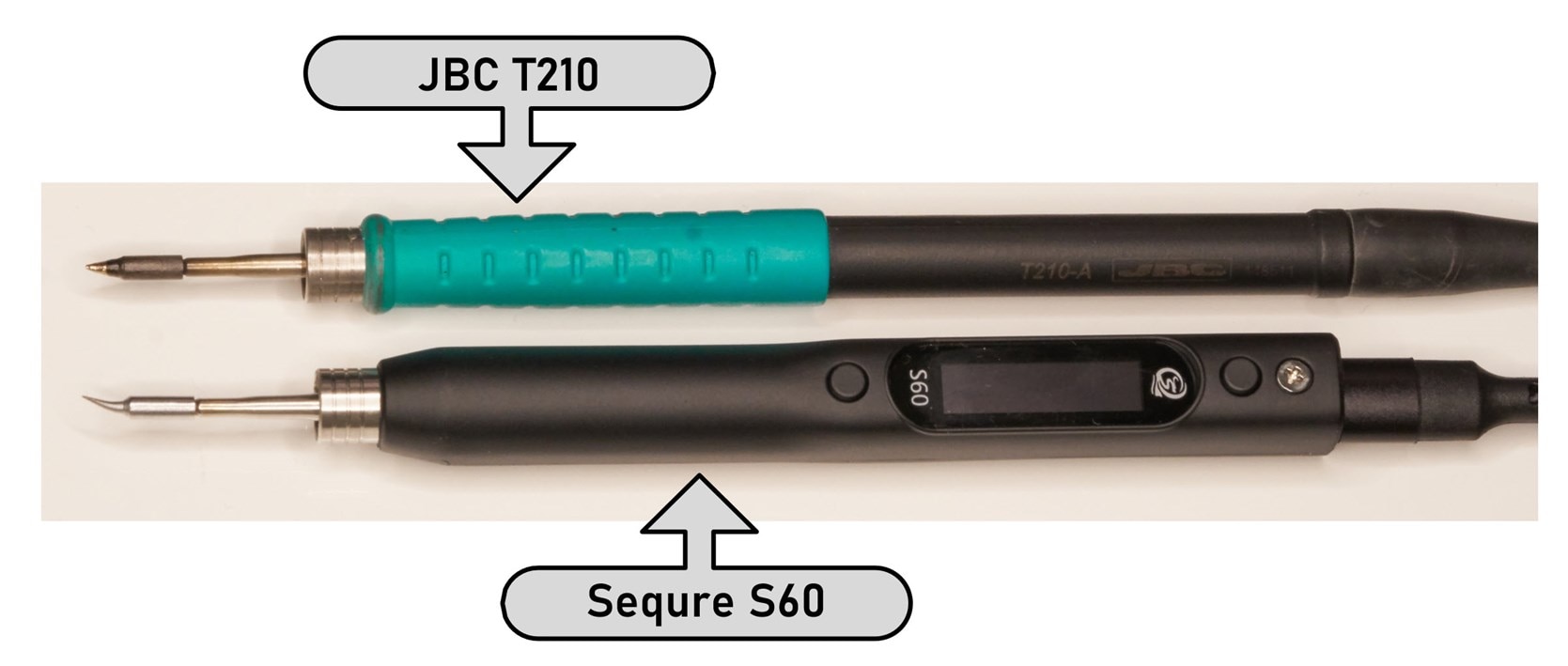
The photo below shows the supplied clone C210 tip, compared against three genuine C210 tips. The contact diameters were accurate (checked with calipers), to within a few hundredths of a millimeter, so the Sequre S60 is physically compatible with genuine tips.

The menu system is fairly sensible, I didn’t find it hard to navigate with the two buttons on either end of the OLED display. I was able to configure it to my preferences, which were flipped display (I use the iron left-handed usually, unlike in the photo above) and 10 degree C increments for the up/down temperature adjustment capability. I also went and set the maximum power to 35%, because I don’t believe I need more power for the small C210 tips I use.
When plugged into a USB-C power supply, the corner of the display shows the measured voltage to be 12.1V, so I knew it had negotiated 12V. The display is very readable.
Usability is great. A long-press turns the iron on, and from then on, you don’t need to press anything (you can press the up/down buttons to choose a temperature of course). If the iron is placed on the desk, then it will auto-sleep in 60 seconds, preserving tip life. There is a 5-minute standby time as well, and these values can be adjusted within the menu system.
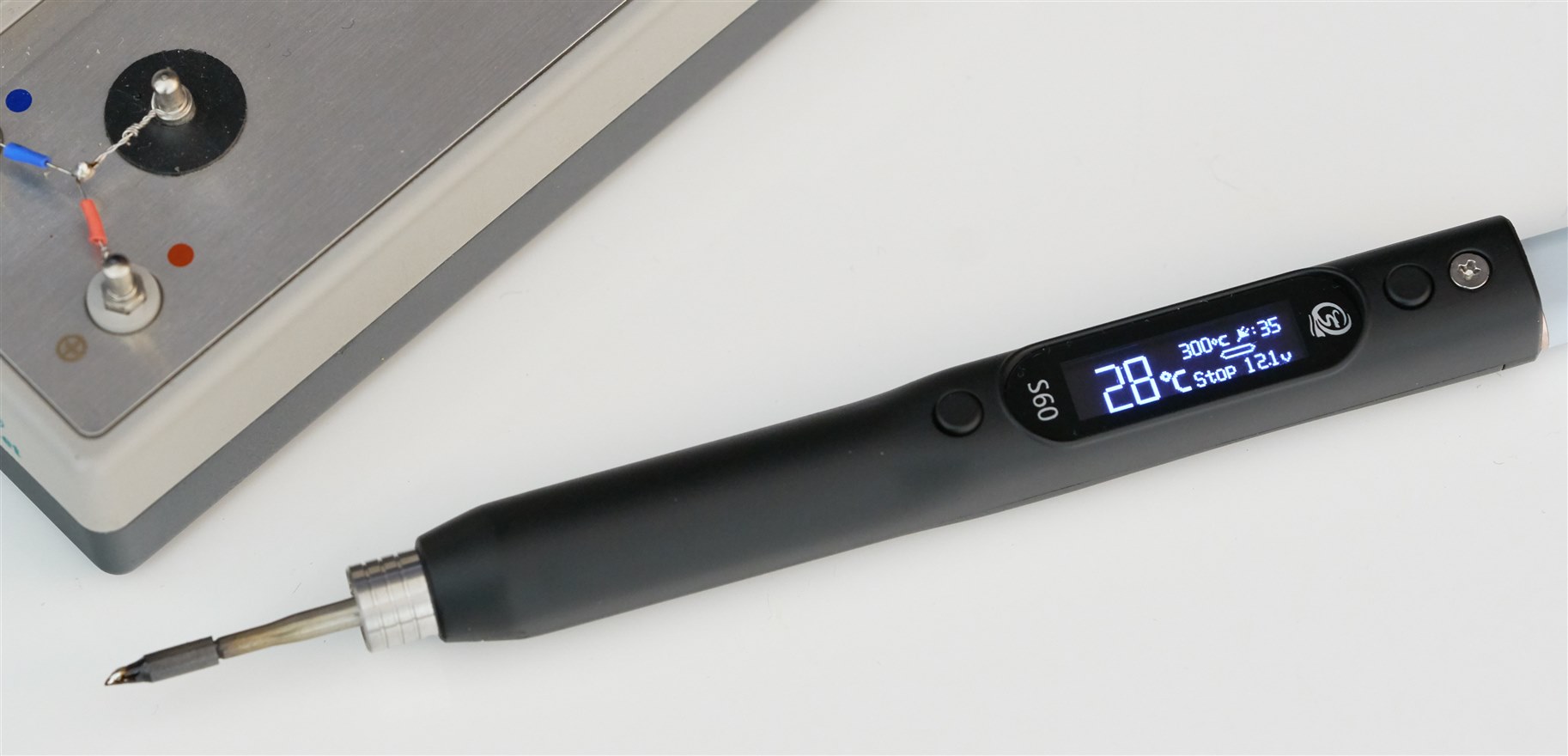
I checked the tip temperature with a calibrated thermometer, and it was near-spot-on at the desired 330 deg C value that I had set (to within 2 degrees!). The supplied tip seems fine and very usable, but I wished to try the tip I use regularly, which is JBC model C210-006 (it costs £21 + tax, but as mentioned earlier, it can last a decade, perhaps longer). The photo above shows it fitted.
With the JBC tip, the temperature was incorrect; the actual temperature was 20 degrees lower than that set on the OLED display. I could calibrate the iron within its settings, but I don’t think I will bother. I like soldering at 330 deg C with the solder that I use, so I will just set the S60 to 350 deg C instead.
I tried doing what I would normally do with that tip in a normal JBC system, and I cannot tell the difference. I can easily use that tool to apply solder to large copper planes, and solder SMA connectors, and I can see the power level bar on the OLED display rise as I do so, so it seems to be functioning just as expected. I don’t think I will run any more rigorous tests, I will simply just use the iron and report if any issues/anomalies occur.
Grounding
There is a screw at the barrel near the USB-C connector end, which can be used for grounding. Alternatively, the outer metal of the USB-C connector could be used. It’s important to ground the iron when working with electronics, so I will have to find a way. I ordered a little grounding cable at the same time when I ordered the soldering iron, so I may use that, or I may try to attach to the USB-C cable shield.
Quick Teardown
A single screw allows for the side panel to be lifted out. The plastic is very hard, like a power tool.
The contacts look nice, and they are held against the shaped circuit board edges, so hopefully they won't fall apart too quickly.
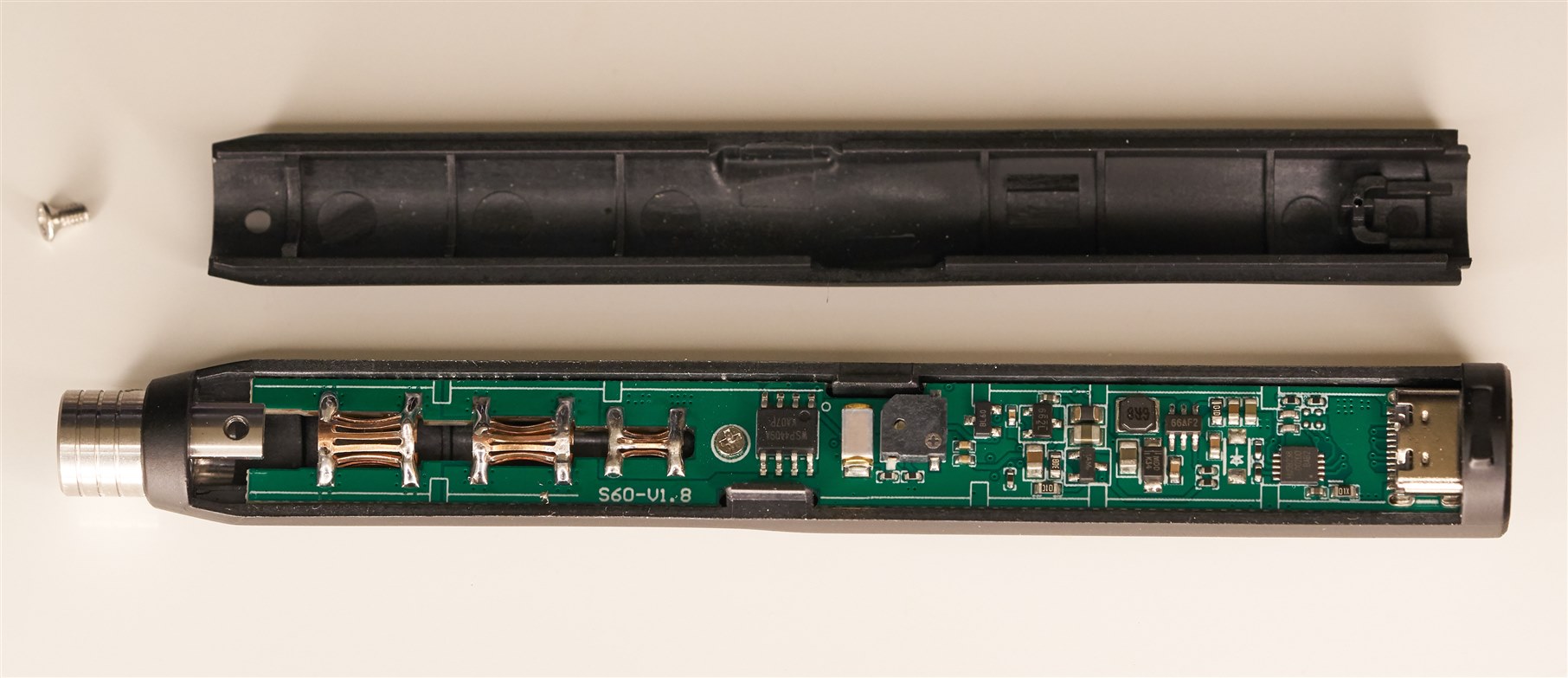
Close-up of the contacts:
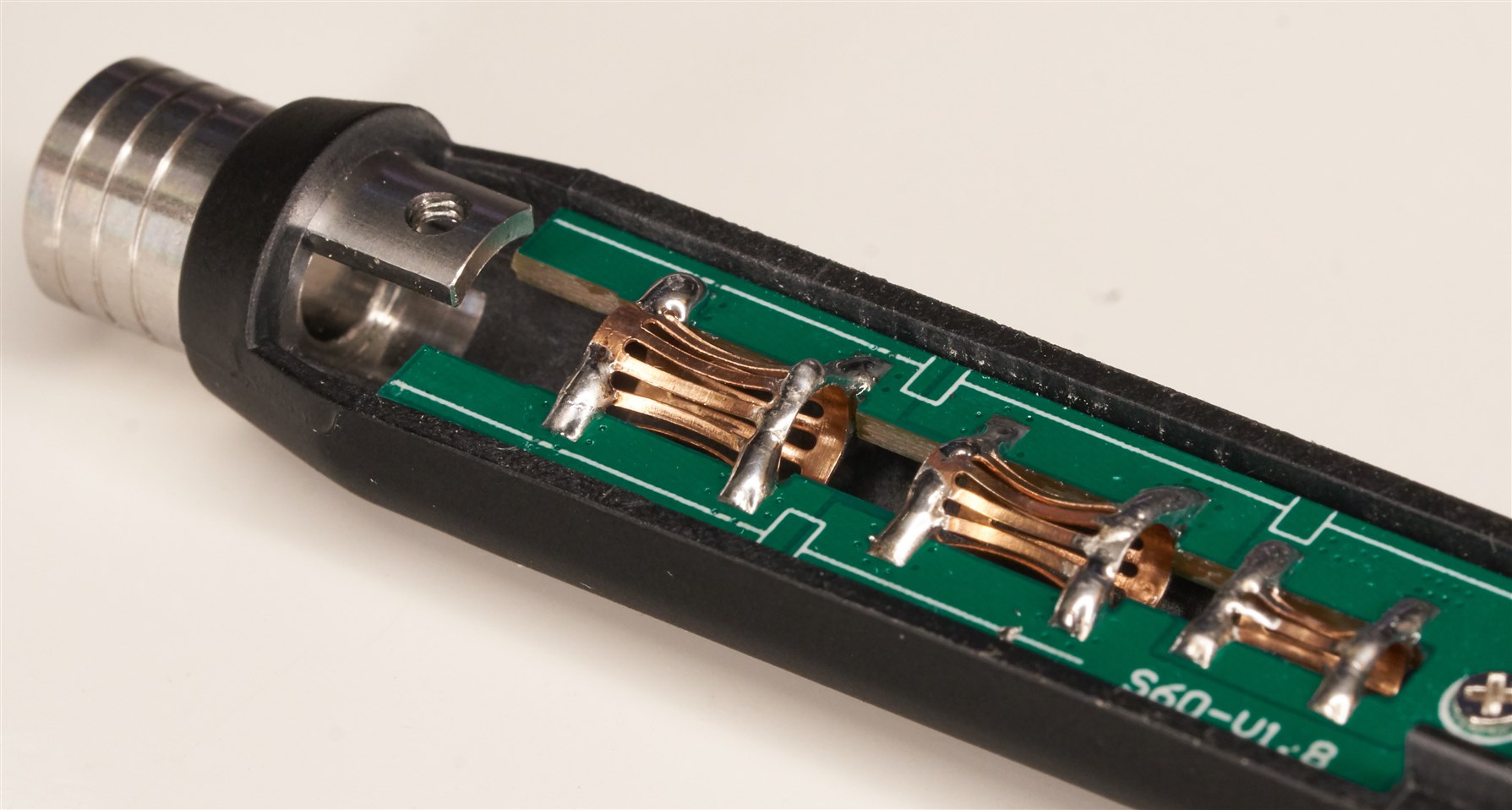
Partial view of circuit (there's more on the other side but I didn't disassemble further):

Things that Could be Improved
The round metal ring close to the tip end isn’t grounded : ( I briefly touch the metal ring on JBC tools frequently to remove any charge on me (the metal ring doesn’t get hot), and I cannot do that with this iron. I will instead have to touch the screw at the other end of the iron (or remember to wear a wrist strap).
I wish a more normal soldering iron tip was supplied. Still, the genuine C210-006 is not expensive if considered usable for a decade, so it is not a major issue.
The supplied plastic stand seems pretty useless to me. The iron can be just placed flat on a desk, it doesn’t roll. A small blob of blue-tack (repositionable putty) makes a simple soldering iron docking area on desks wherever you go : )
Also, the supplied USB cable is pretty useless too, because it is USB-C to USB-A, and I didn’t want to use the supplied European adapter. Instead I used a UGREEN USB-C charger, and a really flexible silicone cable from Anker. I would have preferred for the soldering iron to be supplied with a silicone USB-C-only cable, at slightly lower cost, and let the user buy their own USB-C power source locally.
Things that were Excellent
The performance is stunning. I have not attempted full power, it is set to 35% : ) The size is great, and the display is excellent and can be dimmed and set to switch off in standby, so I think the OLED display could have long life if those things are done. I love that I’m seeing performance that currently seems comparable to the normal soldering station, and with my favourite soldering tip.
Summary
The Sequre S60 seems like a pretty good soldering iron! I have barely used it however, so I have no idea about reliability. I have never used any other USB-C soldering iron, so I cannot compare with others. I can imagine others are pretty impressive too, but I especially wanted compatibility with the existing soldering tips I have.
It seems like a great way to get JBC-like performance at low-cost, and for electronics work, and particularly surface-mount work, the JBC tips ecosysyem is vast, so you can pretty much fine-tune to whatever soldering tip is appropriate for the user and for the task at hand. I have several C210 tips, but the C210-006 works well for all normal work with SOIC, TSSOP, 0402, 0603 and 0805 sized parts, as well as normal through-hole components. The C210 range is not appropriate for very large connectors.
I wish USB soldering iron manufacturers would give more consideration to grounding, rather than leaving that as an exercise for the user to figure out!
Thanks for reading!

Top Comments